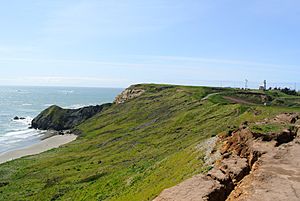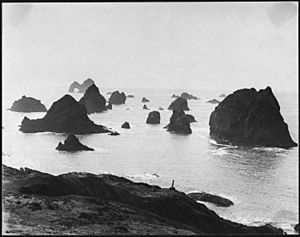Curry County, Oregon facts for kids
Quick facts for kids
Curry County
|
||
|---|---|---|
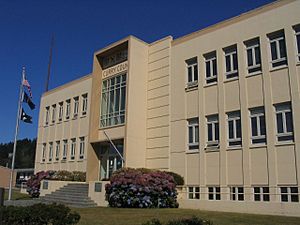
Curry County Courthouse in Gold Beach
|
||
|
||
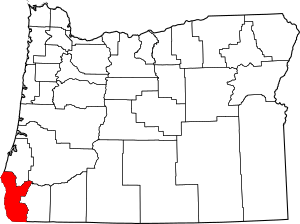
Location within the U.S. state of Oregon
|
||
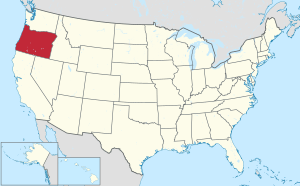 Oregon's location within the U.S. |
||
| Country | ||
| State | ||
| Founded | December 18, 1855 | |
| Seat | Gold Beach | |
| Largest city | Brookings | |
| Area | ||
| • Total | 1,988 sq mi (5,150 km2) | |
| • Land | 1,627 sq mi (4,210 km2) | |
| • Water | 361 sq mi (930 km2) 18.2%% | |
| Population
(2020)
|
||
| • Total | 23,446 | |
| • Estimate
(2021)
|
23,683 |
|
| • Density | 14/sq mi (5.3/km2) | |
| Time zone | UTC−8 (Pacific) | |
| • Summer (DST) | UTC−7 (PDT) | |
| Congressional district | 4th | |
Curry County is the southwesternmost county in the U.S. state of Oregon. As of the 2020 census, the population was 23,446. The county seat is Gold Beach. The county is named for George Law Curry, a two-time governor of the Oregon Territory. Curry County includes the Brookings, OR Micropolitan Statistical Area.
Contents
Geography
According to the U.S. Census Bureau, the county has a total area of 1,988 square miles (5,150 km2), of which 1,627 square miles (4,210 km2) is land and 361 square miles (930 km2) (18%) is water.
The westernmost point in Oregon is in Curry County at Cape Blanco located at 42°50′08″N 124°33′57″W / 42.835508°N 124.565939°W.
The county contains significant forests, with occurrence of black oak, big leaf maple and Douglas-fir. The blue oak, prevalent slightly further south does not reach into Curry County.
Adjacent counties
- Coos County (north)
- Douglas County (northeast)
- Josephine County (east)
- Del Norte County, California (south)
National protected areas
- Oregon Islands National Wildlife Refuge
- Siskiyou National Forest (part)
Demographics
| Historical population | |||
|---|---|---|---|
| Census | Pop. | %± | |
| 1860 | 393 | — | |
| 1870 | 504 | 28.2% | |
| 1880 | 1,208 | 139.7% | |
| 1890 | 1,709 | 41.5% | |
| 1900 | 1,868 | 9.3% | |
| 1910 | 2,044 | 9.4% | |
| 1920 | 3,025 | 48.0% | |
| 1930 | 3,257 | 7.7% | |
| 1940 | 4,301 | 32.1% | |
| 1950 | 6,048 | 40.6% | |
| 1960 | 13,983 | 131.2% | |
| 1970 | 13,006 | −7.0% | |
| 1980 | 16,992 | 30.6% | |
| 1990 | 19,327 | 13.7% | |
| 2000 | 21,137 | 9.4% | |
| 2010 | 22,364 | 5.8% | |
| 2020 | 23,446 | 4.8% | |
| 2021 (est.) | 23,683 | 5.9% | |
| U.S. Decennial Census 1790-1960 1900-1990 1990-2000 2010-2020 |
|||
2010 census
As of the 2010 census, there were 22,364 people, 10,417 households, and 6,347 families living in the county. The population density was 13.7 inhabitants per square mile (5.3/km2). There were 12,613 housing units at an average density of 7.8 per square mile (3.0/km2). The racial makeup of the county was 92.0% white, 1.9% American Indian, 0.7% Asian, 0.3% black or African American, 0.1% Pacific islander, 1.3% from other races, and 3.7% from two or more races. Those of Hispanic or Latino origin made up 5.4% of the population. In terms of ancestry, 26.3% were German, 16.2% were English, 14.1% were Irish, 6.2% were American, and 5.2% were Swedish.
Of the 10,417 households, 18.9% had children under the age of 18 living with them, 48.6% were married couples living together, 8.4% had a female householder with no husband present, 39.1% were non-families, and 32.4% of all households were made up of individuals. The average household size was 2.12 and the average family size was 2.62. The median age was 53.5 years.
The median income for a household in the county was $37,469 and the median income for a family was $53,340. Males had a median income of $41,667 versus $27,188 for females. The per capita income for the county was $23,842. About 9.2% of families and 13.9% of the population were below the poverty line, including 19.0% of those under age 18 and 8.0% of those age 65 or over.
Communities
Cities
- Brookings
- Gold Beach (county seat)
- Port Orford
Census-designated places
- Harbor
- Langlois
- Nesika Beach
- Pistol River
Unincorporated communities
Economy
After discovery of gold and other precious metals along the beaches and rivers of Curry County in the mid-19th century, white settlements developed along the coast. Traveling mainly by water or by coast-hugging land routes, residents remained relatively isolated from the rest of Oregon until the 20th century. As mining declined in the region, the economy became more dependent on farming, livestock grazing, forest products such as Port Orford cedar (also known as Lawson's cypress) and myrtlewood, and tourism. Blueberries and nursery plants are among the important farm products, and most of the Easter lilies grown in the United States come from Curry County.
In 2001, the native tanoak in the county were afflicted by sudden oak death, caused by infection of Phytophthora ramorum. The pathogen, which by 2016 had killed hundreds of thousands of tanoaks in the county, thrives in moist places along the coast. It has killed other kinds of oaks such as California black oak in a region that includes many California counties as well as Curry County, and it has infected and damaged a variety of conifers and shrubs such as camellia. In Curry County, it threatens timber production, plant nurseries, and Christmas tree farms.
As of 2012, the Federal government owned 66 percent of the land in Curry County, while 22 percent was owned by private forest interests. About 7 percent was being farmed; the state of Oregon owned 1 percent, and 4 percent was devoted to other uses.
The Port of Brookings Harbor, a shallow-draft harbor at the mouth of the Chetco River, is considered one of the safest harbors on the coast. It is listed as a Harbor of Refuge by the United States Coast Guard.
See also
 In Spanish: Condado de Curry (Oregón) para niños
In Spanish: Condado de Curry (Oregón) para niños



